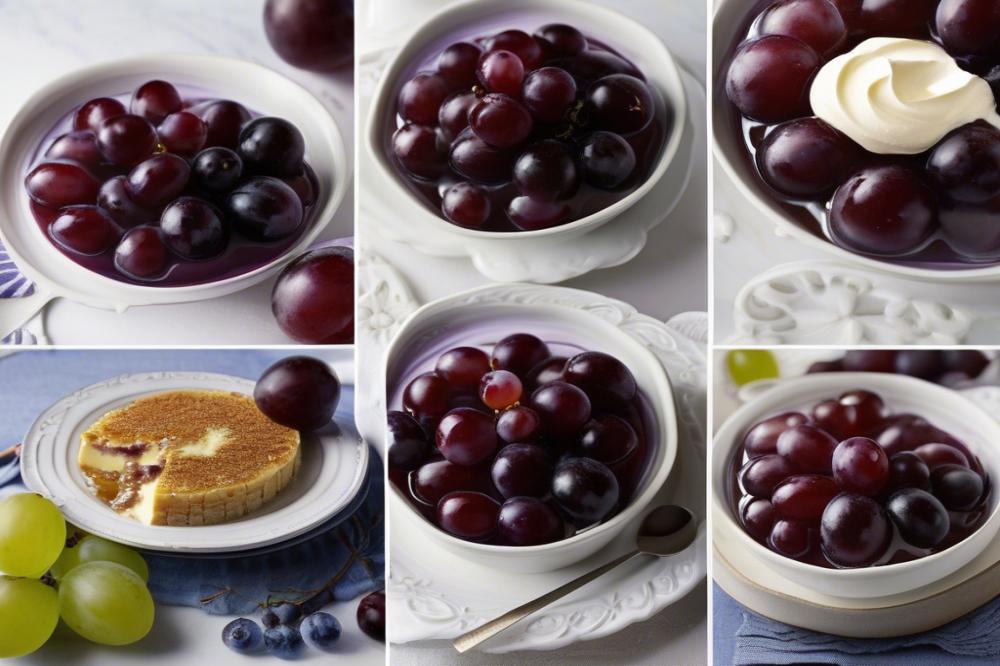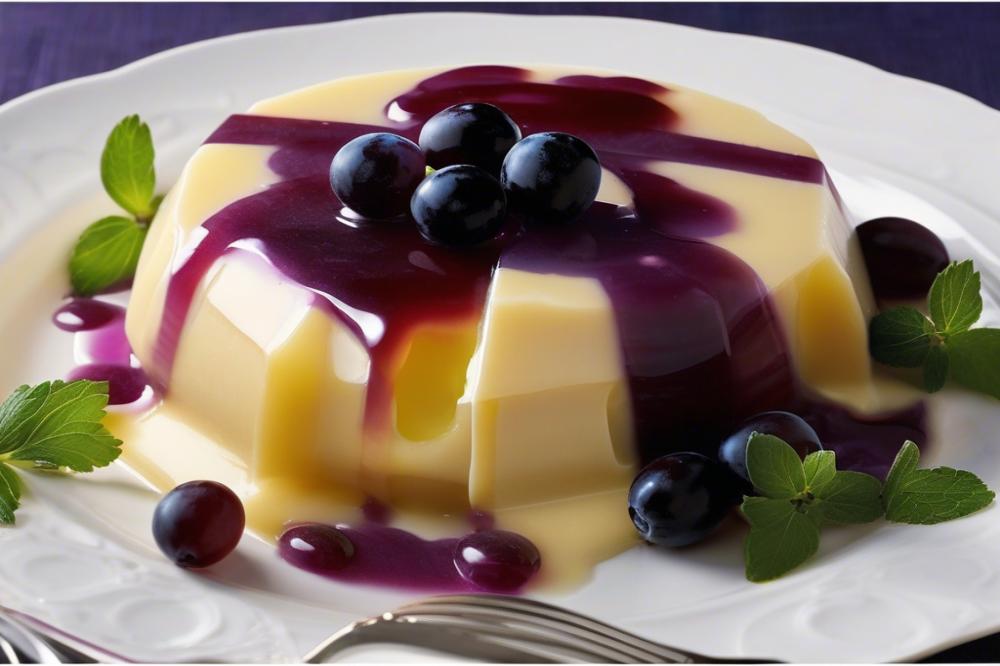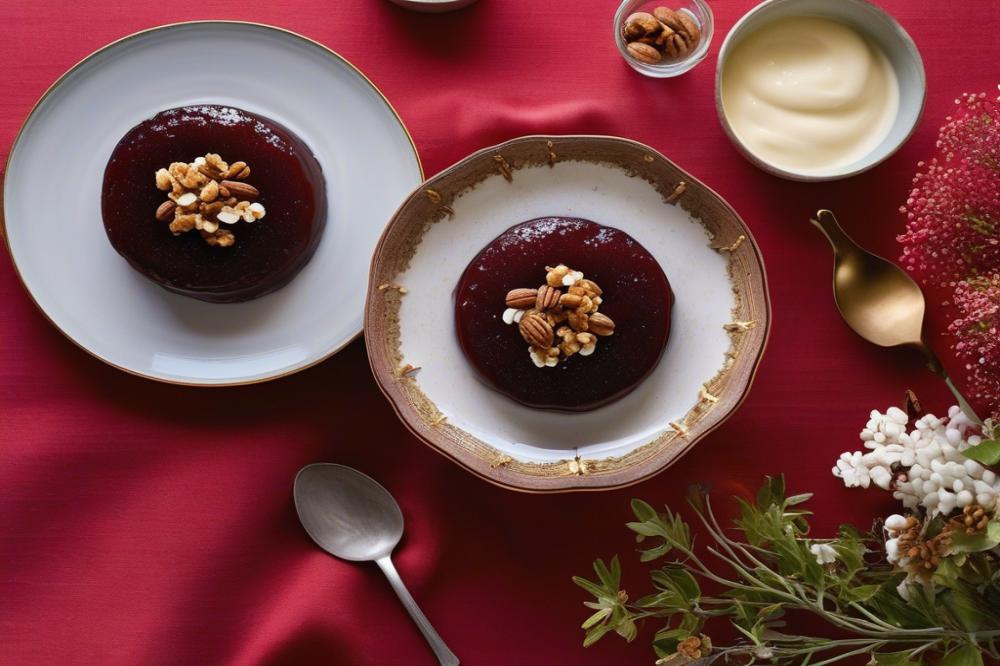Introduction
Moustalevria is a delightful dessert that captures the essence of Greek culture. This traditional dessert, often made during grape harvesting season, highlights the importance of grapes in Greek cuisine. Many cherish it not only for its flavor but also for its rich history, deeply rooted in various regions of Greece.
This sweet dish stands out among easy desserts, serving as a comforting treat. It brings a sense of nostalgia, reminding many of family gatherings and festive occasions. grape pudding, as it is commonly known, showcases the versatility of local ingredients and traditional recipes passed down through generations.
The preparation of Moustalevria is refreshingly simple. Its appeal extends to those following specific dietary choices, being both gluten-free and vegan. With just a few basic ingredients, anyone can create this delicious yet uncomplicated dessert. A thickening agent, often cornstarch, plays a crucial role in achieving that perfect texture.
More than just a dessert, Moustalevria symbolizes warmth and hospitality. It is a treat that can be enjoyed any time, delighting both young and old. Savoring a bite of this Greek grape pudding connects you with a vibrant culinary heritage, proving that sometimes the simplest recipes yield the most satisfying results.
What is Moustalevria?


Moustalevria is a traditional Greek dessert made from grape must. This sweet dish stands out in the world of Greek cuisine. It is often thickened using cornstarch or rice flour. Originating from the Mediterranean regions, grape pudding reflects the agricultural history of Greece. Many families have cultivated grapes for centuries. This delicacy represents a deep connection to the land.
Greek culture celebrates countless traditions, and Moustalevria is no exception. Usually prepared during the harvest season, it forms part of many joyful feasts. Its presence at festivals is a reminder of the bounty of the earth. People in Greece enjoy this dessert as a symbol of community and togetherness. Each spoonful tells a story of long-held customs.
Historical significance plays a key role in various Greek festivals. This pudding often appears at events celebrating the grape harvest. Families often gather to prepare and enjoy it, marking the end of the grape-picking season. It serves as a sweet treat that highlights the importance of agriculture in Greek life. Connecting with loved ones over food strengthens bonds and preserves memories.
Moustalevria is not the only sweet dish in Greek cuisine, but it has a special place. Other popular desserts include baklava and halva, each with its unique preparation methods. While baklava showcases flaky pastry and nuts, Moustalevria relies heavily on its simple ingredients. Many enjoy the fact that it can easily be made gluten-free or vegan, appealing to a modern audience. This pudding offers an easy dessert option for those wanting to explore traditional recipes.
Ingredients and Measurements


To create a delicious Moustalevria, you will need several key ingredients. This simple recipe highlights the natural flavors of grapes in a rich pudding that is both satisfying and enjoyable. Here’s what you’ll need:
- Fresh grape juice: 4 cups, preferably from sweet, ripe grapes.
- Cornstarch: 1/2 cup, which serves as the main thickening agent.
- Sugar: 1/2 cup, adjust according to the sweetness of the grapes.
- Lemon juice: 2 tablespoons, for a touch of brightness.
- Optional: Cinnamon or walnuts for garnishing.
Each ingredient plays a vital role in crafting this traditional dessert. Grape juice forms the base of this sweet dish, imparting flavor and sweetness. Cornstarch is the key thickening agent; it transforms the liquid into a smooth, creamy pudding. Sugar enhances the overall sweetness, creating a delightful balance with the grape juice. Lemon juice not only adds a refreshing zing but also helps to elevate the fruity flavors.
Nutritional Information
Understanding nutrition can help you enjoy this dish healthily. Here’s a breakdown of each significant ingredient’s nutritional profile:
- Fresh grape juice (4 cups): Approximately 420 calories, 0g fat, 108g carbohydrates, and 108g sugars.
- Cornstarch (1/2 cup): About 230 calories, 0g fat, 58g carbohydrates, 0g sugars.
- Sugar (1/2 cup): Roughly 400 calories, 0g fat, 100g carbohydrates, and 100g sugars.
- Lemon juice (2 tablespoons): Approximately 8 calories, 0g fat, 2g carbohydrates, 0g sugars.
This pudding can also fit into various diets. It is a gluten-free treat, making it safe for those with gluten sensitivities. Those who follow a vegan lifestyle will delight in this recipe. Since the ingredients are plant-based, it’s a perfect choice for everyone.
When planning to prepare this Greek cuisine classic, combine these ingredients thoughtfully. The cornstarch will create a delightful texture, making this dessert a satisfying option for any occasion.
Cooking Instructions


Preparing Moustalevria, a delicious Greek grape pudding, involves several steps. Start by gathering your ingredients. You will need fresh grapes, sugar, a thickening agent like cornstarch or arrowroot powder, and water. For a vegan dessert, make sure to use plant-based ingredients.
Step 1: Making the Grape Juice
To begin, rinse the grapes thoroughly. Then, remove the stems and place them into a large pot. Add enough water to cover the grapes and bring the mixture to a boil. After boiling, reduce the heat to a simmer. Crush the grapes gently to release their juices. This process should take about 20 minutes. When done, strain the juice through a fine mesh strainer to separate it from the skins and seeds.
Step 2: Cooking the Pudding
Pour the freshly strained juice back into the pot. Measure the desired amount of juice for your pudding; typically, four cups will serve about six people. Add sugar to taste while the juice is heating. Stir the mixture regularly to help the sugar dissolve. Once the juice is boiling, mix your thickening agent with a little cold water in a separate bowl until smooth. Gradually add this mixture to the boiling juice, stirring constantly.
Step 3: Achieving the Right Consistency
To create a thick pudding, continue to stir the mixture while it cooks. It should begin to thicken after a few minutes. Keep an eye on the texture; if it becomes too thick, you can add a splash of water or more juice. Taste the pudding after a few minutes. Adjust the sweetness and flavor to your liking. After about 10-15 minutes of cooking, the pudding should be ready.
Step 4: Setting and Serving
Pour the thickened pudding into serving dishes. Allow it to cool at room temperature first, and then transfer it to the refrigerator. Let it chill for a few hours, preferably overnight. This will help it firm up nicely. To serve, you can drizzle honey or serve with sliced fruit for added flavor. This dessert shines when garnished with nuts or a sprinkle of cinnamon on top.
Tips for Variations
Feel free to explore variations of this sweet dish. Different grape varieties can change the flavor profile. Use white grapes for a lighter, more delicate taste, while darker grapes create a richer dessert. Adding spices like vanilla or even citrus zest can elevate the dish further.
For a different presentation, try serving the pudding in individual glasses or jars. Layering the Moustalevria with yogurt or fresh berries creates a vibrant and appealing dessert. These ideas not only enhance visual aspects but also add layers of texture and flavor.
Serving Suggestions and Pairings


Moustalevria makes an excellent dessert choice, especially after a rich meal. This delightful grape pudding can be served chilled or at room temperature. Slicing it into squares or cutting it into fun shapes adds an element of surprise for your guests. Plating it on colorful dishes elevates the visual appeal, making it stand out as a beautiful sweet dish.
Complementary Dishes or Beverages
Pairing Moustalevria with complementary flavors can enhance the dining experience. Greek yogurt drizzled with honey creates a delightful contrast, balancing sweetness and creaminess. Fresh fruits like berries or citrus can also brighten up the dish. For those who enjoy beverages, a glass of sweet white wine or a refreshing Greek coffee can elevate the meal significantly. These options pair wonderfully with this gluten-free and vegan dessert.
Presentation Techniques
Enhancing the presentation transforms a simple recipe into something special. Consider garnishing with crushed nuts or a sprinkle of cinnamon. Fresh mint leaves can add a pop of color and freshness. Using a clear glass bowl to showcase the layers of this traditional recipe allows guests to appreciate the texture and thickness of the pudding. Serving it alongside a small dish of lemon zest can provide a refreshing bite that contrasts nicely with the sweet pudding.
Health Benefits of Moustalevria
Moustalevria is not just a delicious dessert; it also brings along a variety of health benefits due to its natural ingredients. The main component of this sweet dish is grapes. These fruits are rich in essential vitamins, particularly vitamin C and vitamin K. They also offer healthy antioxidants that can help combat oxidative stress in the body.
Natural sugars from grapes are the primary source of sweetness in this traditional recipe. Unlike refined sugars, which can lead to energy spikes and crashes, the sugars found in grapes provide a more sustained energy release. This makes grape pudding a smart choice for a sweet treat. Natural sugars also contribute to the overall flavor, making this Greek cuisine delicately sweet without being overwhelming.
Moreover, the dessert is often quite simple to prepare. Using grape juice as a base means you are avoiding artificial sweeteners and preservatives. This is a positive aspect for individuals seeking healthier dessert options. As a delightful addition, grapes contain dietary fiber, which can support digestive health, providing further reasons to enjoy this dish.
The dessert can easily fit into a gluten-free diet. Since it does not contain wheat or any related products, those with gluten sensitivities can enjoy it without worry. This opens up opportunities for everyone at the table to indulge in this traditional dessert.
Another appealing aspect is the vegan aspect. The ingredients required for Moustalevria are plant-based. This makes it a suitable option for people following a vegan lifestyle. It allows them to enjoy a sweet dish that aligns with their dietary choices.
A thickening agent like cornstarch is often used in the recipe. This adds to the creamy texture without the need for dairy. Combining these aspects, you have an easy dessert that is not only tasty but also packed with nutrients.
Enjoying Moustalevria means appreciating a dessert that not only satisfies your sweet tooth but also supports your well-being. So, why not savor its benefits next time you make this delightful grape pudding?
Final Thoughts on Moustalevria
Moustalevria holds a special place in Greek cuisine. This dessert represents a beautiful blend of tradition and flavor. It’s made from simple ingredients but delivers a rich taste that connects people to their heritage. As a grape pudding, it embodies the essence of the Mediterranean, showcasing the natural sweetness of grapes.
Preparation is straightforward, making it accessible for anyone who wants to try their hand at a traditional dish. The steps are uncomplicated, and with a little patience, anyone can create this delightful treat. Imagine serving this fragrant dessert to family and friends. They will appreciate the homemade quality and the story behind it.
By taking the time to make your own Moustalevria, you honor Greek culinary history. Each bite reflects a legacy of flavors passed down through generations. Enjoying this dish invites you to explore more of the rich tapestry of Greek recipes.
So, grab some fresh grapes and get started. Experience how easy it is to create something memorable in your kitchen. Exploring these recipes opens up a world of taste and culture. Embrace the opportunity to reconnect with the past while delighting in a homemade sweet that’s sure to please.



